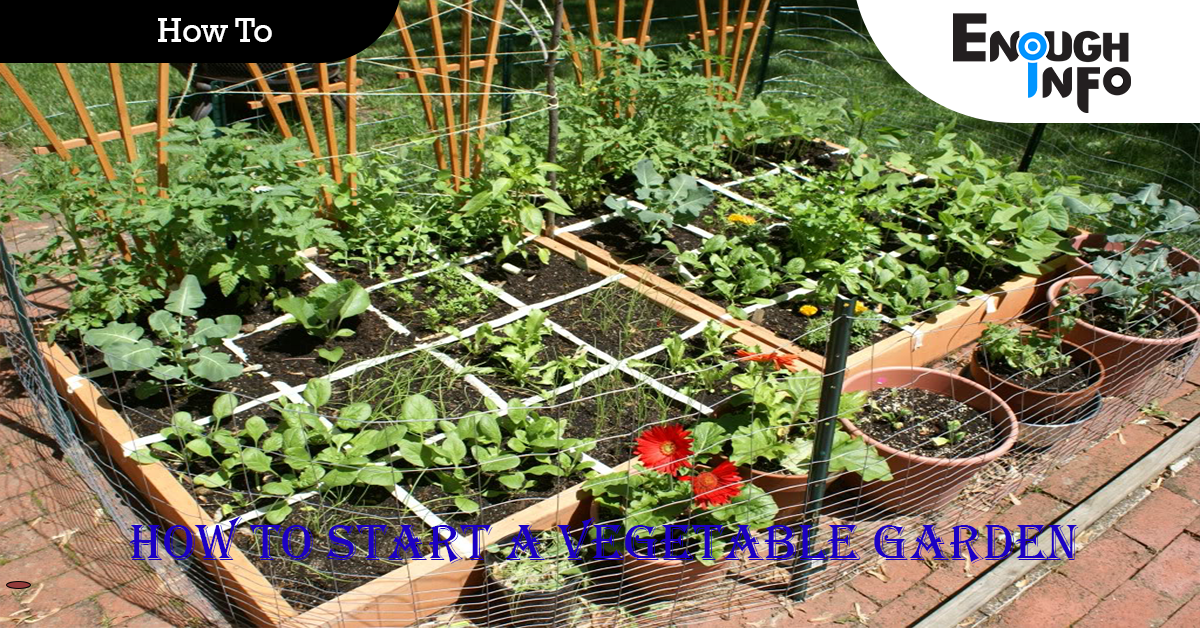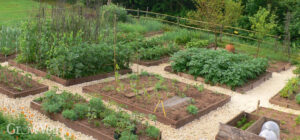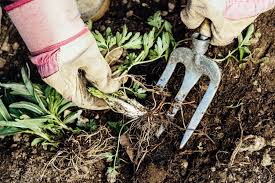How to start a vegetable garden

How to start a vegetable garden – Starting a vegetable garden is a rewarding and fulfilling endeavor that allows you to grow your own fresh and nutritious produce right in your backyard. Whether you have a spacious yard or a small balcony, cultivating a vegetable garden can be a fun and educational experience. EnoughInfo.com
Why garden, you might ask? What about some of the best vegetables and fruits you’ve ever had? If you’ve never had garden-fresh cuisine before, you’ll be blown away by its sweet, juicy flavors and colorful textures. There’s nothing like fresh vegetables, especially if you cultivate them yourself—which you can!

Gardening may appear intimidating at first, but it is a really rewarding activity.
In this article, we will provide you with a step-by-step guide on how to start a vegetable garden, from planning and preparing the soil to selecting the right vegetables and caring for your plants.
Read Also: 30 Hobbies That Make You Money
How to Start Your First Vegetable Garden
Vegetable gardening at home might help you save money while getting in touch with nature. For example, even one tomato plant can be extremely inexpensive. Growing your favorite vegetables and herbs from seed will help you save even more money. You’ll also discover that the flavor and texture of garden-grown vegetables are superior to that of grocery shop produce. In addition, caring for your food garden counts as exercise!
1. Begin with a Small Area
Start small if you’re new to gardening. It’s better to be delighted by what you produce in a little garden than to be frustrated by the time commitment required by a large one. It’s also a good idea to master the fundamentals of gardening before devoting a lot of time and money to this new hobby. You’ll get a sense of how much time gardening requires. You’ll discover whether you enjoy spending time outside planting, watering, and weeding. You’ll also discover how much produce you and your family can consume in a single season. How to clean silver jewelry at home
A beginner’s vegetable garden should be 6×6 feet in size. Choose up to five different varieties of veggies to produce and plant a couple of each. You’ll have enough fresh vegetables for your summer dinners, and keeping up with the tasks will be simple. Growing vegetables in containers is also an excellent way to get started. They don’t even require a yard; a sunny deck or balcony can suffice.
2. Grow Food You Enjoy Eating
What are your favorite foods? Your response will inform you what to plant in your vegetable garden. There are a few other considerations to weigh while determining what to cultivate.
Selective About Varieties
Pay special attention to the seed packet, tag, or label’s description. Each type of vegetable has distinct properties. Some cultivate smaller plants that are perfect for containers or tiny gardens. Other kinds provide greater disease resistance, higher yields, or more heat or cold tolerance. Begin by selecting vegetables that you enjoy eating, then research their sizes and care requirements.
Productivity
Consider how much you and your family will eat and whether you will freeze, can, or give away excess food. Then, be realistic about how many seeds or plants you need to sow. Many newcomers make the mistake of planting excessively. Tomatoes, peppers, and squash produce throughout the season, so you may not need as many plants to meet your needs. Other vegetables, such as carrots, radishes, and corn, can only be harvested once and must be replanted.
Crop Succession
Planting both cool- and warm-weather crops will provide you with a continual harvest of veggies and herbs throughout the spring, summer, and fall. Plant lettuce, greens (such as arugula), peas, radishes, carrots, and broccoli in the early spring. Plant hot-weather favorites like tomatoes, peppers, eggplant, and herbs after you’ve gathered your cool-weather crops. Harvest potatoes, cabbage, and kale in the fall. How to Tie a bowline knot(The Ultimate Guide)
Read Also; 22 Top Foods For Promoting Heart Health(All You Need to Know)
3. Select a Location for Your Garden
Whatever you decide to grow or where you put your garden, there are two essential conditions that your location must meet for the best success: water and light.
A lot of sunlight is required.
Vegetables, like all plants, require sunlight to begin photosynthesis. The quickest-growing veggies require full sun—at least 6 to 8 hours of direct sunlight every day—unobstructed by trees, shrubs, or fences. That’s why planting sun-loving veggies in dark areas won’t yield much success.
Plant vegetables and herbs that tolerate partial shade, such as lettuce, kale, chard, spinach, chives, cilantro, parsley, and thyme, in your yard. Root vegetables such as carrots, radishes, and beets may also be suitable if your site receives at least 4 hours of direct sunlight per day. Alternatively, if you have a sunny patio, try container gardening. That way, you can grow sun-loving veggies and herbs like tomatoes, cucumbers, beans, basil, dill, and rosemary.
Consider Convenient Water Access
The closer your plot is to a water supply, the better. To help these vulnerable plants establish strong roots and shoots, you’ll need to be able to water them frequently during the first few weeks after seeds germinate or seedlings are transplanted. Once your plants have established themselves, a long sip every few days is preferable to a light sprinkle every day.
The water will then travel deeper into the soil, encouraging roots to develop deeper, where they will be better able to acquire nutrients needed to be healthy. Install soaker homes or drip irrigation on a timer to assist reduce water wastage and the amount of time you need to spend watering.
4. Plan the Layout of Your Vegetable Garden
When planning the layout of your vegetable garden, choose between row cropping and intense cropping (both have advantages!). How to play the piano by ear(step-by-step guide)
Cropping in Rows
Plant them in single file in rows at least 18 inches apart so you can walk between them easily. This method is best suited for big vegetable gardens since rows make it easier to battle weeds with mechanical equipment such as tillers. The disadvantage is that the space set aside for walkways limits the number of veggies you can plant.
Tall plants, in general, thrive on the north side of the garden. Peas, cucumbers, and beans are examples of naturally tall plants that can be grown on vertical supports. Make your own A-frame trellis for growing veggies to save money.
Cropping is done intensively.
Increase the production of your garden with intense cropping, which includes planting two or three plants close together in a bed approximately 4 feet wide (also known as a wide row). Seeds or transplants are planted so that their leaves hardly touch when they mature. This method, which makes use of nearly every square inch of prepared soil, works well for most veggies except those that vine, such as cucumbers. The disadvantage of this strategy is that weeding must be done by hand because the plants grow so close together.
The square-foot method is a specific type of intense cropping in which you divide a raised 4×4-foot garden bed into 1-foot squares using a physical grid—such as lattice strips. To fill a 6-inch-high bed, you’ll need 8 cubic feet of high-quality garden soil. The planting formula is straightforward: one extra-large plant per one-foot square, four giant plants per square, nine medium plants per square, and sixteen small plants per square. Mix & mix as you please.
5. Begin Planting in Fertile Soil
Your vegetable garden requires the greatest soil you can provide for the best produce. When you feel rich, healthy soil, you know it: it’s easy to dig and drains nicely. Take a trowel’s worth of soil and hold it in your hands. Does it have a rough feel to it? There is far too much sand.
Is it a powdered substance? There is far too much silt. When wet, does it become sticky? There is far too much clay. The texture of your garden soil is determined by the combination of these three types in specified proportions. This texture influences drainage and nutrient availability.
You want dark, crumbly soil that is absolutely alive with life. Fortunately, regardless of texture, all soil may be improved over time by introducing organic matter. Take, for example, sandy soils. Because they are composed of big soil particles, water and nutrients pass through gaps rather quickly. Adding organic matter—typically compost—to sandy soil helps fill in the crevices between sand particles, allowing plants to retain moisture and nutrients.
Read Also; How To Know If You are Depressed( Best Guide)
Clay soils are the polar opposite. They include very fine, densely packed particles that hold moisture but provide little room for plant roots to grow. Compost aids in the separation of those tiny clay particles, allowing water to drain more readily for plant roots to receive vital oxygen. If you are unsure about the sort of soil you have, send a sample to a state-certified soil-testing laboratory for analysis. How to make a homemade face mask
Furthermore, assessing the soil where you intend to grow food will provide vital information such as pH and nutritional levels. Knowing where you’re starting from is critical for determining what types of soil amendments you may need to add and how much to avoid waste or under-addition.
Spread any necessary additives, such as compost, and work them into the soil using a tiller or shovel to prepare the soil for planting. Stepping on freshly tilled soil will compact it, undoing all your hard work. Then scrape the surface smoothly and carefully moisten it. Allow the bed to rest for several days before planting to allow the soil amendments to do their work.
If you have poor soil, raised garden beds are an easy solution. Construct the raised beds on the existing lawn by coating the bottom of the frames with several layers of newspaper and then filling them with soil. You won’t have to do as much excavating this way.
6. Prepare for pests and diseases.
Some situations necessitate unique solutions, but in general, follow these rules to keep pests away from your vegetables. How To Control A Narcissist (Actions to Take)
Weeds are being stopped in their tracks.
Weeds compete for light, water, and nutrients with your vegetables, so limit them to a minimum. Weeds can be kept at bay by mulching around larger plants like tomatoes with clean straw or compost. To discourage any weed seedlings that do appear, use a hoe.
Keep Animals Away
Deer and rabbits, for example, can wreak havoc in an edible garden. To keep deer out of the garden, an 8-foot-tall barrier is required. To keep rabbits and other burrowing pests out, a fence should extend 6 inches beneath the soil.
Discourage Destructive Insects
Handpicking large insects and caterpillars and dumping them into a pail of soapy water is a safe and effective technique to deal with minor infestations. For larger numbers of insects, use insecticidal soap sprays, which are available at most garden centers. Follow the manufacturer’s instructions when using pest-control pesticides.
Combat Fungal Diseases
Reduce the incidence of fungal illnesses by watering the soil rather than the plant’s leaves. If you use a sprinkler, make sure to use it early in the day so the leaves have time to dry before nightfall. If a plant becomes infected, take it immediately and discard it; do not add diseased plants to your compost pile. Growing disease-resistant vegetable types and changing the position of your plants each year (crop rotation) can also help prevent disease-causing bacteria from multiplying.
7. Harvest and enjoy:
As your vegetables grow and mature, harvest them when they are ripe and ready to be eaten. Follow the specific harvesting guidelines for each vegetable to ensure optimal flavor and quality. Enjoy the fruits of your labor by incorporating your homegrown vegetables into delicious meals for yourself, your family, and your friends.
Read Also; How To Make Money Without A Job (30 Authentic Ways)
FAQs & Answers
1, How much space do I need to start a vegetable garden?
The amount of space you need depends on the vegetables you want to grow and their specific requirements. In general, a small raised bed or container garden can be suitable for beginners with limited space. However, if you have more room available, you can create larger garden beds or expand your garden area accordingly.
2, Can I start a vegetable garden if I don’t have a backyard?
Absolutely! Even without a backyard, you can still start a vegetable garden. Consider options such as container gardening on a balcony or patio. You can grow vegetables in pots, hanging baskets, or vertical gardening systems that utilize vertical space. Just ensure that your chosen location receives sufficient sunlight.
3, How often should I water my vegetable garden?
The frequency of watering depends on various factors, including weather conditions, soil type, and the specific needs of your plants. Generally, vegetables require consistent moisture, so aim to keep the soil evenly moist. Regularly check the moisture level by inserting your finger into the soil. If it feels dry at a depth of about an inch, it’s time to water. Avoid overwatering, as it can lead to root rot and other issues.
4, How do I protect my vegetable garden from pests?
Pests can be a challenge in vegetable gardens. Consider implementing natural pest control methods such as companion planting, where certain plants repel pests or attract beneficial insects. You can also use physical barriers like netting or row covers to prevent pests from reaching your plants. Regularly inspect your garden for signs of pests and take appropriate action, such as handpicking them or using organic pest control solutions if necessary.
5, Can I use chemical fertilizers in my vegetable garden?
While chemical fertilizers can provide nutrients to plants, they are not the only option, and many gardeners prefer organic alternatives. Organic fertilizers, compost, and well-rotted manure are popular choices for nourishing vegetable plants. They improve soil health and long-term sustainability while reducing the risk of chemical buildup in the soil.
6, How long does it take for vegetables to grow in a garden?
The time it takes for vegetables to grow varies depending on the specific plant and variety. Some fast-growing vegetables like radishes and lettuce can be harvested within a few weeks, while others, like tomatoes and peppers, may take several months. Check the seed packets or seedling labels for estimated harvest times, and remember that patience is key in gardening.
7, Do I need to rotate my vegetable crops each year?
Crop rotation is a beneficial practice that helps prevent soil depletion and reduces the risk of diseases and pests. It involves changing the location of different plant families each year. If space permits, consider rotating your vegetable crops to maintain soil health and optimize overall garden productivity.
8, How can I extend the growing season for my vegetable garden?
To extend the growing season, you can utilize techniques such as using cold frames, row covers, or hoop houses to protect your plants from frost and chilly temperatures. Additionally, choosing cold-tolerant vegetable varieties and planting them earlier in the spring or later in the fall can help you enjoy fresh produce for a longer period. How To Emotionally Connect With A Taurus Man
Read Also; Top Healthy Foods To Eat Everyday(2023 Guide)
Conclusion:
Starting a vegetable garden allows you to connect with nature, grow your own food, and enjoy the benefits of fresh and healthy produce. By following these steps and giving your garden the attention it needs, you can embark on a fulfilling gardening journey. Remember to learn from your experiences, experiment with different vegetables, and embrace the joy of watching your garden flourish. Happy gardening! How To Paint A Sunset With Acrylics(The Ultimate Guide)




